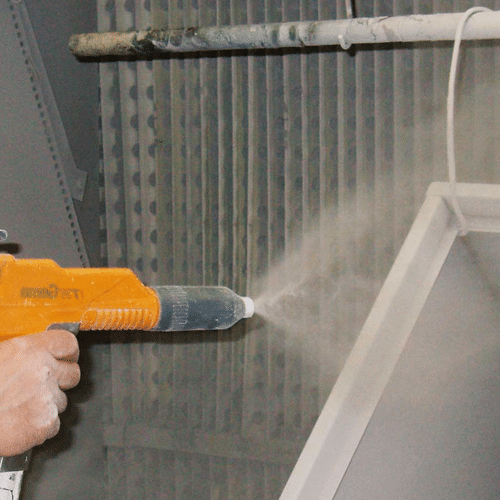Powder-Coated Toilet Partitions
Can you tell me more about powder-coated partitions – how are they made? Is powder-coating the right choice? How is it different from painted metal?
When you read about powder-coated toilet partitions on our site, we are referring to a style of budget-friendly bathroom stall fabricated predominantly from steel. During production, the manufacturer applies a thin layer to the exterior of the steel component to improve its appearance and toughness. This layer is applied using a powder-coating process from which the entire material gets its name.
As implied, a fine powder coats the surface of the metal during the process. The powder consists of special polymers that protect the surface and make it colorful. Powder-coating involves a few necessary steps. First, workers clean the metal part and treat it with chemicals that will help the coating process. Using powder-coating specific equipment, the workers electrically charge both the metal and the powder. Then, they spray the powder into the air surrounding the metal object. Because the electrical charges present are complementary, the metal immediately pulls any powder floating in the air nearby to its surface. This method results in an exceptionally even covering on the metal. Lastly, the powder-covered metal is placed in an industrial oven to cure. When the evenly distributed powder is heated, it flows together to seal the metal and adhere to it. Also, the heat changes it’s chemical composition to make it harder. The final product (a toilet partition panel, door, or pilaster) now has a smooth, colorful finish that will protect it from everyday stains, smudges, and corrosion.
Baked Enamel Toilet Partitions
How are baked enamel toilet partitions different from powder coated? They look the same to me. I’ve even heard the two terms used to describe the same product!
Powder-coated steel bathroom stalls have largely superseded baked enamel toilet partitions in the North American marketplace. Primarily, this is because of the better appearance and resiliency of powder-coated steel compared with baked enamel steel. The powder-coating process is also more environmentally friendly than using enamel.
Enamel is somewhat similar to paint – it consists of a liquid mixture that includes the color and protection chemicals mixed with additives. Some additives keep the mixture liquid so that it can be easily applied. These additives are intended to evaporate during curing. Yet more additives help the enamel adhere to the metal surface. While this basic system works well for many paints, it can lead to problems when used with toilet partitions.
Toilet partitions with baked enamel finishes are much more susceptible to drips and surface imperfections occurring during production. Even when carefully applied – using a spray gun, for instance – liquids may shift and become uneven.
Occasionally, the additives meant to keep the enamel mixture in liquid form may not fully evaporate after application. Sometimes, this is attributable to an error when the enamel was mixed. In other cases, the curing process might not have been long enough. Either way, the resulting finish will not be as tough as it could be. It may be more susceptible to physical contact, which could result in scratches. Also, the finish may be more reactive when exposed to water or cleaning chemicals.
Products can’t have drips or ripples in their finishes, and toilet partition components should endure frequent use and abuse with minimal signs of wear. Given the advantages of powder-coat over baked enamel, it is obvious why the toilet partition industry shifted towards the more consistent technique that results in a stronger finish.
An additional deficiency of the baked enamel finishing processes is that it produces high levels of volatile organic compounds – abbreviated as VOCs. As mentioned earlier, enamel contains additives meant to keep the mixture in a liquid state so that it can be easily applied. These additives are called solvents. They create VOCs as they evaporate during the curing process. The release of VOCs contributes to the anthropogenic warming of the planet. Acute exposure to VOCs can negatively impact an individual’s respiratory and immune systems. VOC exposure also triggers allergic reactions and sensory irritation in some people. Limiting VOC emission, whether for the benefit of the global environment, manufacturing safety, or both factors, often means choosing an alternative to enamel coatings.
To the casual observer, baked enamel restroom stalls look nearly identical to powder-coated steel partitions. The comparable appearance and the similarities in the finishing processes (applying a colored coating over steel) lead to confusion even among more experienced shoppers.
Painted Steel Toilet Partitions
What do people mean when they say “painted steel?” Is it the same as baked enamel, powder coating? Is it something completely different?
“Painted steel” is a blanket term that covers any steel toilet partitions with a protective, colorized layout on the exterior – including powder-coated partitions. Technically speaking, powder coating is not a method of painting. Powder coat is applied differently than paint, and it results in a much stronger finish. However, because powder coating and painting achieve a similar effect, we sometimes still use the term.
Many times, the phrase “painted steel” is explicitly used to contrast powder-coated stalls with stainless stalls. Believe it or not, powder-coated steel toilet partitions have quite a bit in common with stainless steel stalls. While the finish and durability of the two styles vary greatly, they utilize similar designs and production techniques. For instance, both use a full honeycomb below the surface to provide rigidity and sound deadening. Both types also feature a metal bar that runs around the outer edge of panels, doors, and pilasters that locks the components into place.

